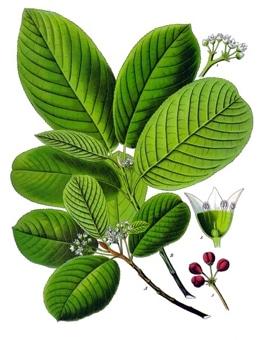

Just ask your pharmacist
Cascara means “bark” in Spanish. The bark of this shrubby tree has been used for at least 1,000 years as a powerful laxative and is still collected for that purpose. Pharmaceutical companies process 5 million pounds of cascara bark from the Pacific Northwest annually for use in laxatives. Due to these laxative properties, it is a good idea NOT to use cascara for hot dog or marshmallow sticks when camping or picnicking.
Range
Usually in the understory, found throughout western Oregon on moist, well-drained sites. It typically grows as a second-generation tree after alders have grown on barren soil.
Character
It is easy to spot because of buds covered only by soft fuzz during winter. Seldom taller than 40 feet and often more shrubby. It features tiny flowers, each with five greenish-yellow petals. Its fruit is bright red at first, quickly changing to deep purple or black.
Understory
The cherry-like fruit is inedible to humans. Grouse and raccoons eat the fruit and will pass the seed undigested, so it may be widely distributed.
Climate
It grows on the western side of the state, spanning from British Columbia down into northern California.
Management
Cascara sprouts vigorously, so is often found in stands that have been logged or burned.